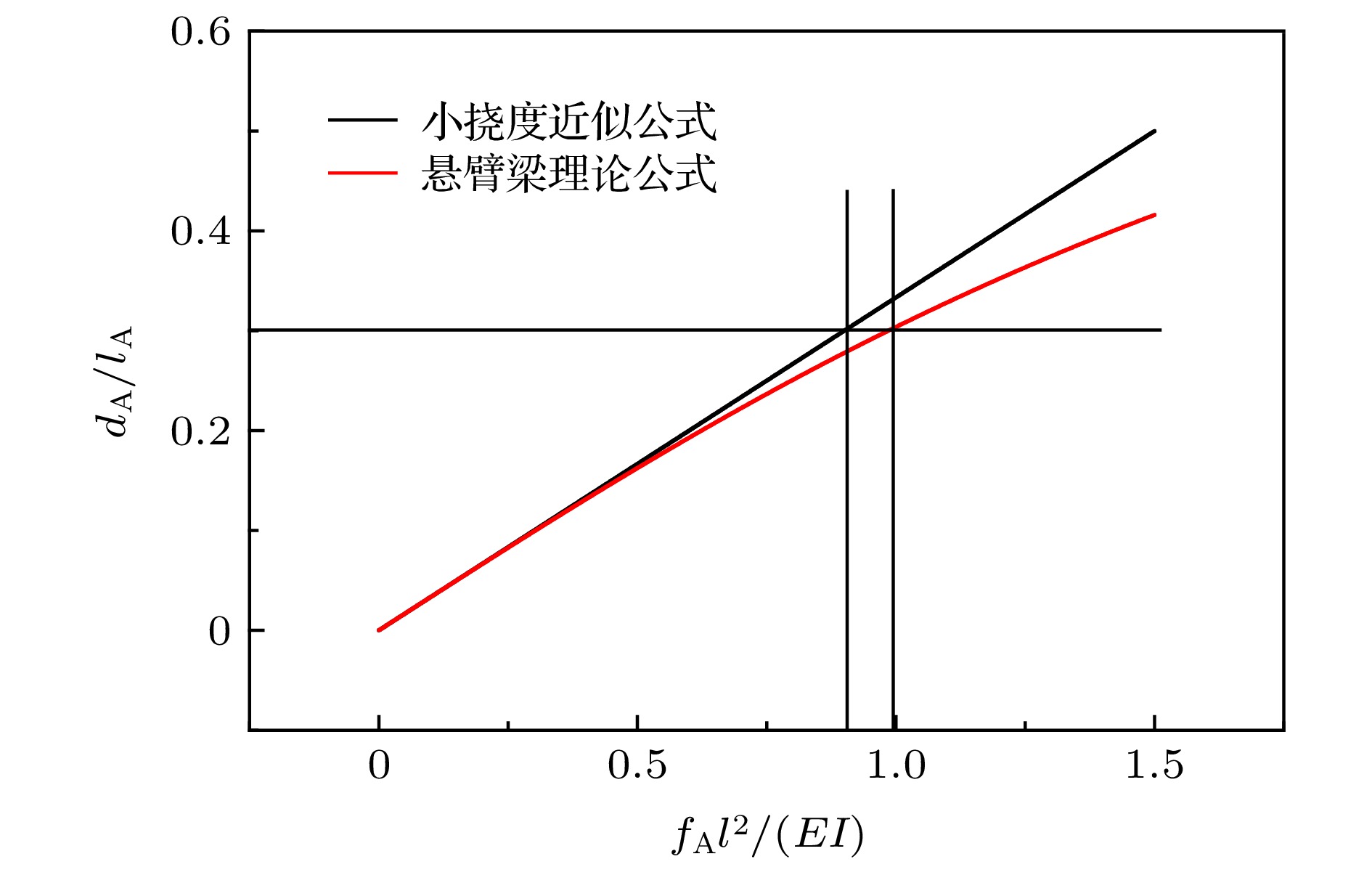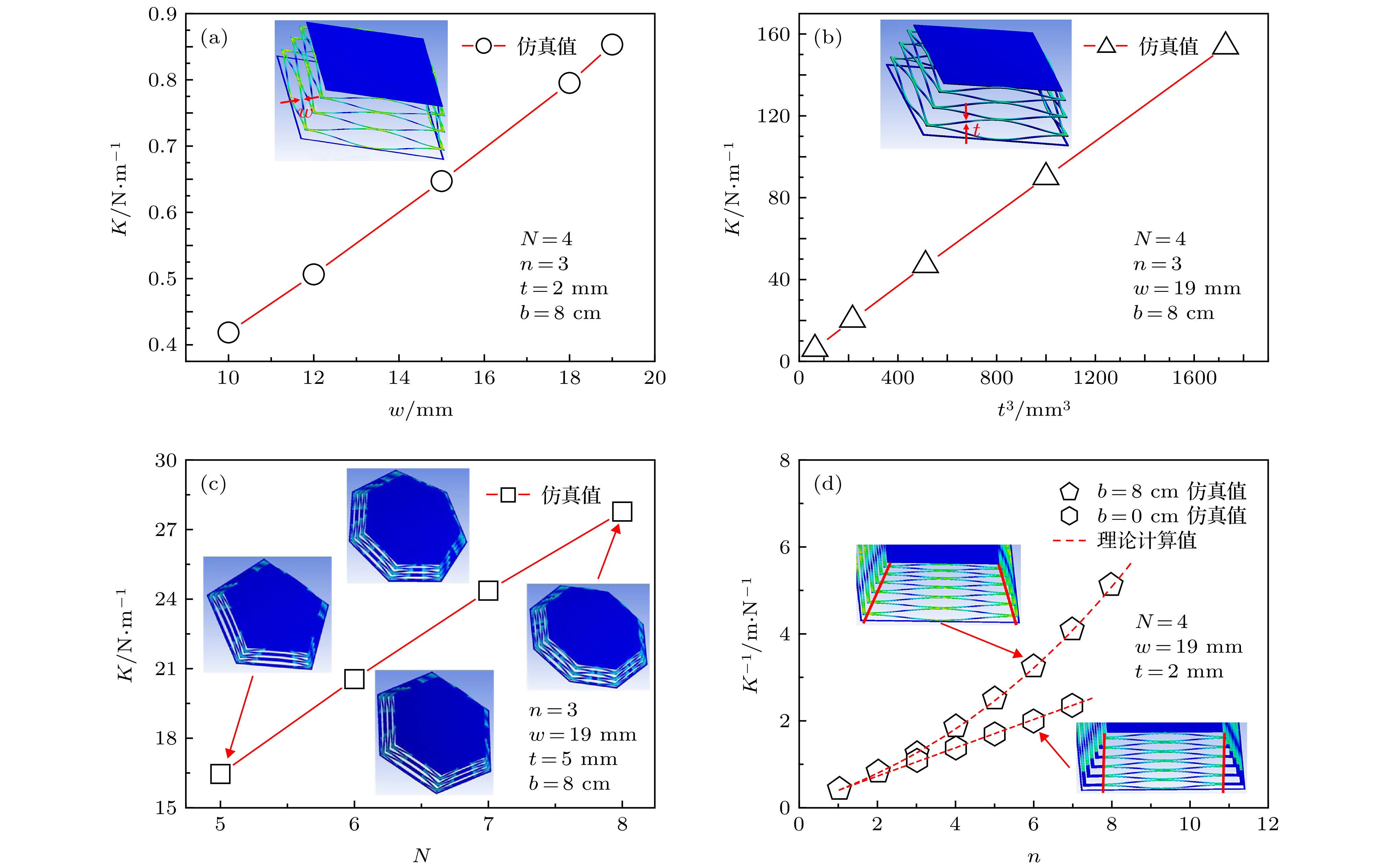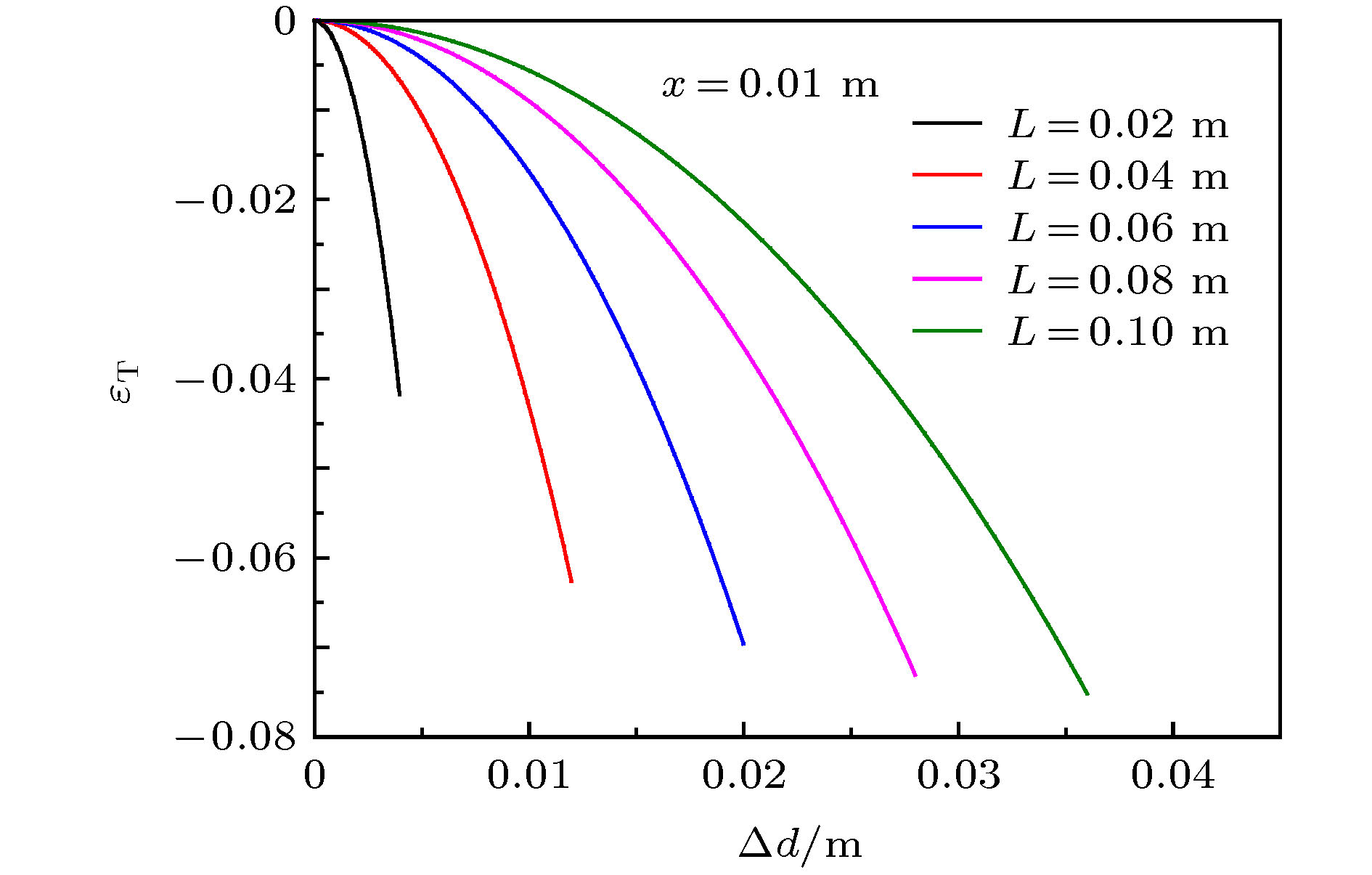-
Kirigami, the art of cutting paper, recently emerged as a powerful tool to substantially modify, reconfigure and program the properties of material. The development of kirigami technology provides an effective solution for designing the inorganic flexible electronic devices. Pyramid kirigami, as a kind of kirigami structure, shows a large vertical extension characteristic. It has been widely used to demonstrate versatile applications, such as graphene kirigami spiral spring, three-dimensional stretchable supercapacitor, and wearable flexible sensors. In the present work, we construct a polygonal radial symmetric pyramid kirigami by introducing some cuts in the elastic sheet. The mechanical behavior of pyramid kirigami is investigated based on the cantilever formula solved by Galerkin method. In addition, a “beam model” is proposed to explain deformation process of pyramid kirigami, which consists of several “beam elements” containing two cantilever beams. The formula for the relationship between the elastic coefficient K and the structural parameters of the regular N-sided pyramid kirigami of n modules is obtained by combining several cantilever beams. The formula for the linear threshold of deformation DT is obtained based on the comparison between the approximate curve of small deflection and the theoretical curve of a cantilever beam. When the deformation of the structure exceeds the linear threshold, the structure cannot keep the elastic coefficient K value linear any more, and the mechanical behaviors become non-linear. The simple geometric relationship of a single module is used to explain the out-of-sheet distortion of the structure. The proposed theoretical model is confirmed by finite element method simulation and experimental methods, and it is used to analyze the mechanical characteristics of graphene krigami reported. The results indicate that the defined parameters can be adjusted to tailor or manipulate the ductility and mechanical behaviors. This work provides theoretical support for the application of pyramid kirigami in the field of flexible devices. In the macroscopic field, the pyramid kirigami structure is expected to be applied to the field of flexible devices as a flexible structure with controllable elastic coefficient. In the microscopic field, it is expected to use two-dimensional materials to make force measurement devices with a simple visual readout and femtonewton force resolution.
-
Keywords:
- Kirigami /
- radial symmetry /
- graphene /
- flexible devices
[1] Blees M K, Barnard A W, Rose P A, Roberts S P, McGill K L, Huang P Y, Ruyack A R, Kevek J W, Kobrin B, Muller D A, McEuen P L 2015 Nature 524 204
 Google Scholar
Google Scholar
[2] Chen B G, Liu B, Evans A A, Paulose J, Cohen I, Vitelli V, Santangelo C D 2016 Phys. Rev. Lett. 116 135501
 Google Scholar
Google Scholar
[3] Shyu T C, Damasceno P F, Dodd P M, Lamoureux A, Xu L, Shlian M, Shtein M, Glotzer S C, Kotov N A 2015 Nat. Mater. 14 785
 Google Scholar
Google Scholar
[4] 陈珊珊, 刘幸, 刘之光, 李家方 2019 物理学报 68 248101
 Google Scholar
Google Scholar
Chen S S, Liu X, Liu Z G, Li J F 2019 Acta Phys. Sin. 68 248101
 Google Scholar
Google Scholar
[5] Han T, Scarpa F, Allan N L 2017 Thin Solid Films 632 35
 Google Scholar
Google Scholar
[6] Rafsanjani A, Pasini D 2016 Extreme Mech. Lett. 9 291
 Google Scholar
Google Scholar
[7] Rafsanjani A, Bertoldi K 2017 Phys. Rev. Lett. 118 084301
 Google Scholar
Google Scholar
[8] Rafsanjani A, Jin L, Deng B, Bertoldi K 2019 Proc. Natl. Acad. Sci. U.S.A. 116 8200
 Google Scholar
Google Scholar
[9] Hanakata P Z, Qi Z, Campbell D K, Park H S 2016 Nanoscale 8 458
 Google Scholar
Google Scholar
[10] 王沅倩, 林才纺, 张景迪, 何军, 肖思 2015 物理学报 64 034214
 Google Scholar
Google Scholar
Wang Y Q, Lin C F, Zhang J D, He J, Xiao S 2015 Acta Phys. Sin. 64 034214
 Google Scholar
Google Scholar
[11] Lyu J, Hammig M D, Liu L, Xu L, Chi H, Uher C, Li T, Kotov N A 2017 App. Phys. Lett. 111 161901
 Google Scholar
Google Scholar
[12] Zhang X J, Yuan Z H, Yang R X, He Y L, Qin Y L, Xiao S, He J 2019 J. Cent. South Univ. 26 2295
 Google Scholar
Google Scholar
[13] Xiao S, Wang H, Liu S, Li M, Wang Y W, Chen J Z, Guo L H, Li J B, He J 2018 Chin. Phys. Lett. 35 067801
 Google Scholar
Google Scholar
[14] Zhao Y, Wang C, Wu J, Sui C, Zhao S, Zhang Z, He X 2017 Phys. Chem. Chem. Phys. 19 11032
 Google Scholar
Google Scholar
[15] 韩同伟, 李攀攀 2017 物理学报 66 066201
 Google Scholar
Google Scholar
Han T W, Li P P 2017 Acta Phys. Sin. 66 066201
 Google Scholar
Google Scholar
[16] He Z, Xiong J, Dai Q L, Yang B C, Zhang J, Xiao S 2020 Nanoscale 12 6767
 Google Scholar
Google Scholar
[17] He S, Qiu L, Wang L, Cao J, Xie S, Gao Q, Zhang Z, Zhang J, Wang B, Peng H 2016 J. Mater. Chem. A 4 14968
 Google Scholar
Google Scholar
[18] Yang C, Zhang H, Liu Y, Yu Z, Wei X, Hu Y 2018 Adv. Sci. 5 1801070
 Google Scholar
Google Scholar
[19] Tsien H S 1953 J. Am. Rocket Soc. 23 14
 Google Scholar
Google Scholar
[20] 赵则昂, 邓宗白, 宋安平 2014 力学与实践 3 341
 Google Scholar
Google Scholar
Zhao Z A, Deng Z B, Song A P 2014 Mech. Eng. 3 341
 Google Scholar
Google Scholar
[21] 王冬梅 2008 纸和造纸 2 82
 Google Scholar
Google Scholar
Wang D M 2008 Paper and Paper Making 2 82
 Google Scholar
Google Scholar
[22] 韩同伟, 贺鹏飞, 骆英, 张小燕 2011 力学进展 41 279
 Google Scholar
Google Scholar
Han T W, He P F, Luo Y, Zhang X Y 2011 Adv. Mech. 41 279
 Google Scholar
Google Scholar
[23] Zhu Y, Wang P, Xiao S, He S, Chen J, Jiang Y, Wang Y, He J, Gao Y 2018 Nanoscale 10 21782
 Google Scholar
Google Scholar
[24] Lamoureux A, Lee K, Shlian M, Forrest S R, Shtein M 2015 Nat. Commun. 6 8092
 Google Scholar
Google Scholar
-
图 4 FEM模拟和理论计算验证弹性系数与结构参数关系 (a)−(c) 弹性系数K分别与梁宽w、厚度t的三次方及边数N值呈线性变化关系; (d) 取不同模块切口长度L的增加值b, 验证K值与模块数n的关系, 点为模拟值, 虚线为计算值
Fig. 4. Verify the relationship between elastic coefficient and structural parameters through FEM simulation and theoretical calculation: (a)−(c) The elastic coefficient K varies linearly with the beam width w, the cube of thickness t, and the number of sides N; (d) take different values b to verify the relationship between the elastic coefficient K and the number of modules n. The points are simulation values, and the dotted lines are calculated values.
图 5 利用实验对K, DT的计算公式(11)和(14)式进行验证 (a) 实验图; (b) 四边形实验数据, 点为测量结果, 虚线红色为线性区域拟合结果, 黑色虚线为计算出的线性阈值; (c) Nature上发表的石墨烯剪纸弹簧在激光驱动下的形变-受力结果[1]
Fig. 5. The K and DT formulas (11) and (14) are verified experimentally: (a) Experimental picture; (b) the experimental data of the quadrangular pyramid structure, the points are the measurement results, the red dotted line is the linear region fitting result, and the black dotted line is the calculated linear threshold; (c) laser-driven deformation of graphene kirigami springs published in Nature[1].
-
[1] Blees M K, Barnard A W, Rose P A, Roberts S P, McGill K L, Huang P Y, Ruyack A R, Kevek J W, Kobrin B, Muller D A, McEuen P L 2015 Nature 524 204
 Google Scholar
Google Scholar
[2] Chen B G, Liu B, Evans A A, Paulose J, Cohen I, Vitelli V, Santangelo C D 2016 Phys. Rev. Lett. 116 135501
 Google Scholar
Google Scholar
[3] Shyu T C, Damasceno P F, Dodd P M, Lamoureux A, Xu L, Shlian M, Shtein M, Glotzer S C, Kotov N A 2015 Nat. Mater. 14 785
 Google Scholar
Google Scholar
[4] 陈珊珊, 刘幸, 刘之光, 李家方 2019 物理学报 68 248101
 Google Scholar
Google Scholar
Chen S S, Liu X, Liu Z G, Li J F 2019 Acta Phys. Sin. 68 248101
 Google Scholar
Google Scholar
[5] Han T, Scarpa F, Allan N L 2017 Thin Solid Films 632 35
 Google Scholar
Google Scholar
[6] Rafsanjani A, Pasini D 2016 Extreme Mech. Lett. 9 291
 Google Scholar
Google Scholar
[7] Rafsanjani A, Bertoldi K 2017 Phys. Rev. Lett. 118 084301
 Google Scholar
Google Scholar
[8] Rafsanjani A, Jin L, Deng B, Bertoldi K 2019 Proc. Natl. Acad. Sci. U.S.A. 116 8200
 Google Scholar
Google Scholar
[9] Hanakata P Z, Qi Z, Campbell D K, Park H S 2016 Nanoscale 8 458
 Google Scholar
Google Scholar
[10] 王沅倩, 林才纺, 张景迪, 何军, 肖思 2015 物理学报 64 034214
 Google Scholar
Google Scholar
Wang Y Q, Lin C F, Zhang J D, He J, Xiao S 2015 Acta Phys. Sin. 64 034214
 Google Scholar
Google Scholar
[11] Lyu J, Hammig M D, Liu L, Xu L, Chi H, Uher C, Li T, Kotov N A 2017 App. Phys. Lett. 111 161901
 Google Scholar
Google Scholar
[12] Zhang X J, Yuan Z H, Yang R X, He Y L, Qin Y L, Xiao S, He J 2019 J. Cent. South Univ. 26 2295
 Google Scholar
Google Scholar
[13] Xiao S, Wang H, Liu S, Li M, Wang Y W, Chen J Z, Guo L H, Li J B, He J 2018 Chin. Phys. Lett. 35 067801
 Google Scholar
Google Scholar
[14] Zhao Y, Wang C, Wu J, Sui C, Zhao S, Zhang Z, He X 2017 Phys. Chem. Chem. Phys. 19 11032
 Google Scholar
Google Scholar
[15] 韩同伟, 李攀攀 2017 物理学报 66 066201
 Google Scholar
Google Scholar
Han T W, Li P P 2017 Acta Phys. Sin. 66 066201
 Google Scholar
Google Scholar
[16] He Z, Xiong J, Dai Q L, Yang B C, Zhang J, Xiao S 2020 Nanoscale 12 6767
 Google Scholar
Google Scholar
[17] He S, Qiu L, Wang L, Cao J, Xie S, Gao Q, Zhang Z, Zhang J, Wang B, Peng H 2016 J. Mater. Chem. A 4 14968
 Google Scholar
Google Scholar
[18] Yang C, Zhang H, Liu Y, Yu Z, Wei X, Hu Y 2018 Adv. Sci. 5 1801070
 Google Scholar
Google Scholar
[19] Tsien H S 1953 J. Am. Rocket Soc. 23 14
 Google Scholar
Google Scholar
[20] 赵则昂, 邓宗白, 宋安平 2014 力学与实践 3 341
 Google Scholar
Google Scholar
Zhao Z A, Deng Z B, Song A P 2014 Mech. Eng. 3 341
 Google Scholar
Google Scholar
[21] 王冬梅 2008 纸和造纸 2 82
 Google Scholar
Google Scholar
Wang D M 2008 Paper and Paper Making 2 82
 Google Scholar
Google Scholar
[22] 韩同伟, 贺鹏飞, 骆英, 张小燕 2011 力学进展 41 279
 Google Scholar
Google Scholar
Han T W, He P F, Luo Y, Zhang X Y 2011 Adv. Mech. 41 279
 Google Scholar
Google Scholar
[23] Zhu Y, Wang P, Xiao S, He S, Chen J, Jiang Y, Wang Y, He J, Gao Y 2018 Nanoscale 10 21782
 Google Scholar
Google Scholar
[24] Lamoureux A, Lee K, Shlian M, Forrest S R, Shtein M 2015 Nat. Commun. 6 8092
 Google Scholar
Google Scholar
计量
- 文章访问数: 6465
- PDF下载量: 104
- 被引次数: 0














 下载:
下载:








